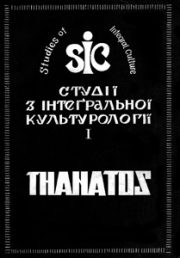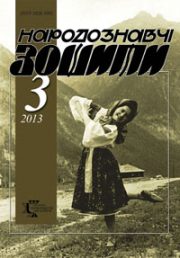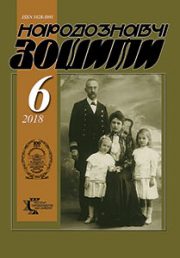The Ethnology Notebooks. 2023. № 5 (173), 1226—1240
UDK [39:697.2](282.247.32-192.2)”18/19″
DOI https://doi.org/10.15407/nz2023.05.1226
RADOVYCH Roman
- ORCID ID: http://orcid.org/0000-0002-1900-8948
- Doctor of Sciences in History,
- Senior Researcher of the Institute of Ethnology
- of the National Academy of Sciences of Ukraine,
- in the Department of Historical Ethnology,
- 15, Svobody Avenue, 79000, Lviv, Ukraine,
- Contacts: e-mail: radovychroman@gmail.com
Abstract. Among a number of typological features that characterize traditional dwelling, the heating system occupies an important place. Considering the fact that in relation to the terrain of the Middle Transdniprian region, this issue has never been a subject of special interest to scientists, the proposed work is extremely relevant.
The author sets himself the goal of analyzing the design features of smoke removal devices and the processes of functional segmentation of the stove (the emergence of a recumbent stove, a riser stove, a kitchen stove, etc.). The object of the study is the residential heating system of the Central Transdniprian region and the subject design features of smoke removal devices and functional segmentation of the furnace. The methodological basis of the research is the principle of historicism in combination with elements of structural and functional analysis and the use of the main methods of ethnological science: retrospective, typological, complex and analysis, historical reconstruction, etc. The research territory covers the entire massif of the Central Transdniprian region. Chronological boundaries — the 19th — the first half of the 20th century.
The work uses separate information about smoke removal methods and functional furnace segmentation, which contain sources of the 17th—18th centuries, 19th — early 20th centuries, as well as the author’s field materials collected during expeditions in 2008—2010.
The main heating device in the houses was a stove in the territories of the Central Dnieper region In the 19th — at the beginning of the 20th century.
Smoke collector was placed above the stove opening (on the right-bank of Ukraine — hinged or straight-walled) in the semi-smoke and ‘white-heated’ stoves. Chimney was mounted (on the right-bank of Ukraine — a chimney-stand, and on the left-bank of Ukraine, next to the chimney-stands, hanging chimneys were also widely used) in the halls of houses, heated in ‘white’.
Keywords: heating system, chimney-smoke collector, chimney-outlet, stove-stand, stove-recliner, combustion chamber.
Received 5.09.2023
REFERENCES
- Olyanchyn, D. (1937). Description of the Travel of the Swedish Ambassador to Ukraine 1656—1657. In The Notes of the NTSh (Vol. СLІV, pp. 41—69). Lviv: NTSh [in Ukrainian].
- Beauplan, Guillaume de Levasseur, &. Kravets, Ya. (1990). Description of the Ukraine, several provinces of the Kingdom of Poland, stretching from the borders of Moskov to the borders of Transylvania, together with their customs, way of life and warfare. In Guillaume Levasseur de Beauplan. Description of Ukraine. Prosper Merime. Ukrainian Cossacks. Bohdan Khmelnytskyi Kravets (Pp. 17—114). Lviv: Kamenyar [in Ukrainian].
- Markovich, J. (1798). Notes on Malorossiya, its inhabitans and products (Part 1). SPb.: under the Provincial Board [in Russian].
- Shafonsky, A. (1851). Chernigov governorship topographic description with a brief geographical and historical description of Little Russia from parts of which this governorship is composed. Kiev: In the University Printing House [in Russian].
- De la Flies, D.P., Boryak, H., & Dashkevich, Ya. (Eds.). (1999). Albums (Vol. 2). Kyiv: Institute of Ukrainian Archeography and Source Studies named after M. Hrushevsky National Academy of Sciences of Ukraine [in Ukrainian].
- Zelenin, D.K. (1916). Description of the manuscripts of the scientific archive of the Imperial Russian Geographical Society (Issue 3, pp. 989—1279). Petrograd: Printing house A.V. Orlov [in Russian].
- Zelenin, D.K. (1915). Description of the manuscripts of the scientific archive of the Imperial Russian Geographical Society (Issue 2, pp. 485—988). Petrograd: Printing house A.V. Orlov [in Russian].
- Fundukley, I. (1852). Statistical description of the Kiev province (Part 1). SPb: In printing houses of the Ministry of Internal Affairs [in Russian].
- Rusov, M.A. (1902). Settlements and buildings of peasants in the Poltava province. Collectionof the Kharkov Historical and Philological Society (Vol. 13). Kharkov: Pechatnoe Dilo [in Russian].
- Myloradovych, V. (1991). The life-being of a Luben peasant. Ukrainians: popular beliefs, belief, demonology (Pp. 170—341). Kyiv: Lybid [in Russian].
- (2020). Ethnographic image of modern Ukraine. Corpus of expeditionary folklore and ethnographic materials. People’s housing culture. Ecology and organization of habitat (Vol. 9) [in Ukrainian].
- Kosmyna, T. (1999). Stellement, mansion, housing. In Ukrainian: Historical and ethnographic monography: in two books (Vol. 2, pp. 13—57). Opishne: Ukrainian Genre Studies [in Ukrainian].
- Chubinsky, P.P. (1877). Russians of the South-Western Territory: housing, utensils, farm buildings and tools. In Proceedings of the ethnographic and statistical expedition to the West Russian Region, equipped with the Russian Geographical Society of the South-West Division (Vol. 7, issue 2, pp. 339—606). SPb. [in Russian].
- Hrushevskyi, M. (2002). From the life of peasants in the Chihyryn region. Sights of Ukraine: history and culture, 2, 127—135 [in Ukrainian].
- Kovalenko, G. (1912). About Ucrainian style and Ucrainian house. Ucrainian house (Pp. 166 — 201, 272 — 282). Kyiv [in Ukrainian].
- Sharko, A. (1901). Little Russian housing. Ethnographic review, 4, 119—131 [in Russian].
- Svyryda, R. (2013). Monuments of folk construction of the forest-steppe Kyiv region and the National Museum of Folk Architecture and Life. Problems of preservation, reproduction and popularization of historical and cultural Heritage in the context of open-air museums (Vol. 1, pp. 252—262). Lviv: Apriori [in Ukrainian].
- (1858). Life of the Malorussian peasant (Mostly in the Poltava province). Ehtnographic collection published by the Imperial Russian Geographic Society (Issue III, pp. 19—46). SPb.: In the printing house of Eduard Prats [in Russian].
- Rusov, A.A. (1899). Description of the Chernigov province (Vol. 2). Chernigov: Printing House of the Provincial Zemstvo [in Russian].
- Padalka, L.V. (1905). What did the population of the Poltava provincesey about their old life. Proceedings of the Poltava Scientific Archive Commission (Issue 2, pp. 22—29). Poltava [in Russian].
- Schmidt, A. (1863). Materials for the geography and statistics of Russia were collected by officers of the general staff. Kherson province (Part 1). St. Petersburg [in Russian].
- Radovych R. (2021). Traditional rural housing of the third quarter of the 19th century on the territory of Podilsk province (according to source materials). The Ethnology notebooks. 3, 524—542 [in Ukrainian].
- (1873). Materials for the study of the Podilsk province in statistical and economic relations. Kamenets-Podilsk: Typography of the Provincial Administration [in Ukrainian].
- Kosmyna, T. (1986). Traditions and innovations in the architecture of the people’s of Kyiv and Kyiv Region. Etnography of Kyiv and Kyiv Region: Traditions and Modernity (Pp. 157—200) Kyiv: Naukova dumka [in Ukrainian].
- Bagaliy, D.I. (1990). History of Slobid Ukraine. Kharkiv: Osnova [in Ukrainian].
- Prykhodko, N.P. (1975) Some issues of the history of housing in Ukraine. The ancient dwelling of the peoples of Eastern Europe (Pp. 245—275) [in Russian].
- Blomkvist, E.E. (1956). Peasant buildings of Russians, Ukrainians and Belorussians: (settlements, dwellings and economic structures). In East Slavic ethnographic collection: Essays on folk material culture of Russians, Ukrainians and Belarusians in the 19 — early 20 centuries (Pp. 3—458). Moscow: Publishing House of the Academy of Sciences of the USSR [in Russian].
- Laschuk, Yu.P. (1967). Ceramics. History of Ukrainian art: in 6 vol. Art of the 14th — first half of the 17th century (Vol. 2, pp. 389—399). Kyiv [in Ukrainian].
- Szymanski, A. (1995). Heating systems and devices. Comments to the Polish Ethnographic Atlas (Vol. 2, pp. 214—242). Wroclaw: PTL [in Polish].
- Chizhikova, L.N. (1988). Russian-Ukrainian border guards: history and destinies of traditional everyday culture. Moskow: Nauka [in Russian].
- Shcherbakivskyi, V., & Ulyanovsky, A. (Ed.). (1995). Ukrainian Art: Selected Unpublished Works. Kyiv: Lybid [In Ukrainian].
- Lininsky, P. (1998). Returned from nothingness. The emergence and development of relief tiles in Galicia. Lviv [in Ukrainian].
- Kolupayeva A. (2006). Ukrainian tiles of the nineteenth and early twentieth centuries. History. Typology. Ikonognrafiya. Ensemblivist. Lviv: Institute of Ethnology of the National Academy of Sciences of Ukraine [in Ukrainian].
- Sergeeva, M. (1999). Formation of the interior of medieval housing. In Ukrainian: historical and ethnographic monography in two books (Vol. 2, pp. 65—74). Opishne: Ukrainian Genre Studies [in Ukrainian].
- Kwasniewski, K. (1963.). Hearths and stoves in Polish folk architecture. Studies based on ethnographic materials from the second half of the 19th and 20th centuries. Wroclaw; Warsaw; Krakow: Ossolinski People’s Institution, publishing house of the Polish Academy of Sciences [in Polish].







